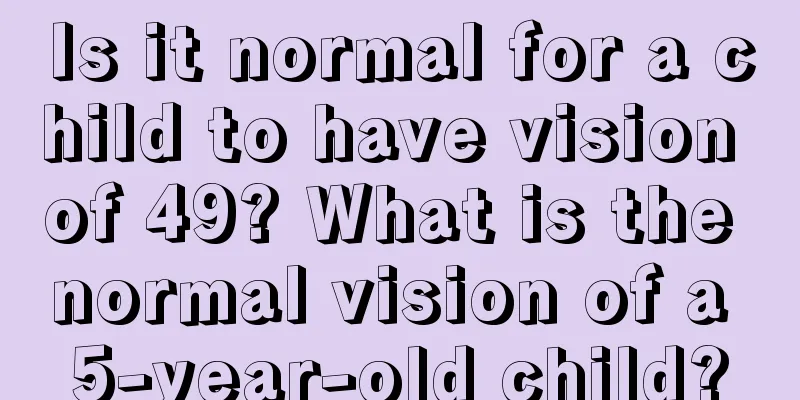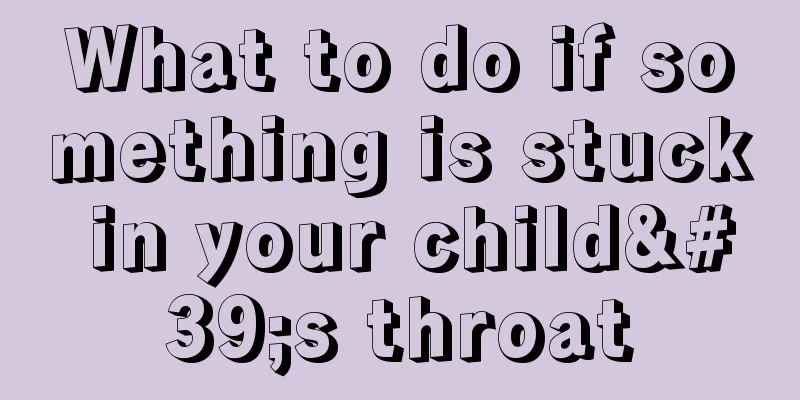Is it normal for a child to have vision of 49? What is the normal vision of a 5-year-old child?

|
When children reach a certain age, parents will pay more attention to their children's eye health. As they play games or watch TV for a long time, parents will worry that these bad habits may lead to eye damage. In fact, this is true. Generally, at a normal age, it is necessary to judge the child's vision development standard based on the eye chart, so that parents can take timely prevention measures. Children's vision development standards To determine whether a child's vision is developing normally, we should first know the normal vision range at different age stages. Based on the literature reports on measuring the visual acuity of infants using different methods (OKN, VEP, PL), most experts believe that the visual acuity of newborns and infants one month after birth is light perception ~ eye and manual, two months old is eye and manual ~ 0.01, three months old is 0.01 ~ 0.02, four months old is 0.02 ~ 0.05, six months old is 0.06 ~ 0.08, eight months is 0.1, one year old is 0.2 ~ 0.3, two years old is 0.5 ~ 0.6, and may reach about 1.0 at three years old. But at the same time, some studies have pointed out that visual development varies, some earlier, some later, but most scholars believe that normal adult vision can only be developed after the age of 6 (or even 10). More children's vision development standards >> Baby's vision development: what smart mothers must know: How to make baby's vision development healthier Baby vision impairment examination method Method 1: Observe eye movements Observe whether the baby has tremors when moving his eyeballs. If there are rapid left and right shaking of the eyeballs, there is a high probability that the baby has visual impairment. Test 2: Observe the ability of the eyes to track objects Place a red ball of wool with a diameter of 10 cm at a distance of 15 cm from the baby's eyes. A one and a half month old baby's eyes can follow the red ball of wool from right to left or from left to right to the midline; a four month old baby's eyes can move 180 degrees from right to left or from left to right with the red ball of wool. Method 3: Observe whether a responsive smile occurs A 2-month-old baby will show a responsive smile when someone faces him and teases him (but no sound can be made and the baby's body cannot be touched). Test 4: Observe the ability of eyes to focus on objects When the baby is 4 and a half months old, he can stare at colored pills, such as sugar pills, small balls, etc., placed on the table with both eyes. Friendly reminder: If your baby does not meet the requirements of the above examinations when he is 4 and a half months old, he may have visual impairment and needs to go to the ophthalmologist for further examination as soon as possible. |
<<: Why are children's hands shaking?
>>: What to do when your child has a toothache?
Recommend
When will the baby's fontanelle close and what should I do if it closes prematurely?
The baby's fontanelle will close automaticall...
What should I do if my baby can't speak clearly?
In daily life, every couple in every family wants...
What are the reasons why children have fever?
In people's daily lives, there are always som...
White flakes on the child's scalp
Children's hair is relatively easy to clean b...
What causes children to grind their teeth at night?
For children, good sleep is the key to ensuring d...
What is the reason for the baby's thumb to bend inward?
Babies are the apple of their parents' eyes a...
Newborn baby has no bowel movement on the second day?
If the newborn does not have a bowel movement on ...
Why does my baby have a severe cough?
I believe that mothers will find this phenomenon ...
The order of adding complementary food to children
When the baby is about four months old, we will s...
Causes of mesenteric lymphadenitis in children
We know that children's disease resistance an...
What is the cause of white ringworm on the face of a 4-year-old child?
Although children do not care much about their ap...
What are the common methods of children's nutrition recipes?
Nowadays, more and more people pay attention to t...
Symptoms of autistic children
Autism is a very common disease nowadays. There a...
Can a two-month-old baby use air conditioning?
As the weather is getting hotter, babies will als...
How to train children's willpower?
Children are the most precious treasures in the h...









